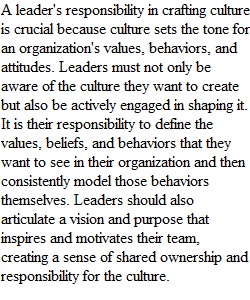


Q • Unit 3 Discussion Video: Ah Yes, The Proverbial Catch 22 • What is a leader’s responsibility in crafting culture? • Why do ideas become self-reinforcing? • What are the answers to the “two fundamental questions” in an organization in which you’ve been a member?Describe the organization and the answers to the questions: “How will we win?” and “How will we work together? • How could organizations build a culture that is perpetually open to change? Use these questions to guide your thinking and help you jump into dialogue with your classmates. Just find something related to the discussion video that genuinely interests you and discuss it. • Incorporate APA-formatted citations and references from the course readings in your responses, as needed, to demonstrate your understanding of key concepts • See the Instructor Guidelines tab of the Introduction module for discussion guidelines. • See the APA-Formatted References tab of the Introduction module for a list of LSAL 5133 sources in APA-format. • See the Syllabus or Calendar link on the left side of this page for due dates. o By the end of Week 5 - Post your initial response (250 words or more) o By the end of Week 6 - Make 4 additional replies to your peers or instructor (100 words or more) • You must post your initial response before you will see your classmates' responses • Click on the 3 vertical dots in the upper right corner of the discussion thread then choose Show Rubric to see how this assignment will be graded.
View Related Questions